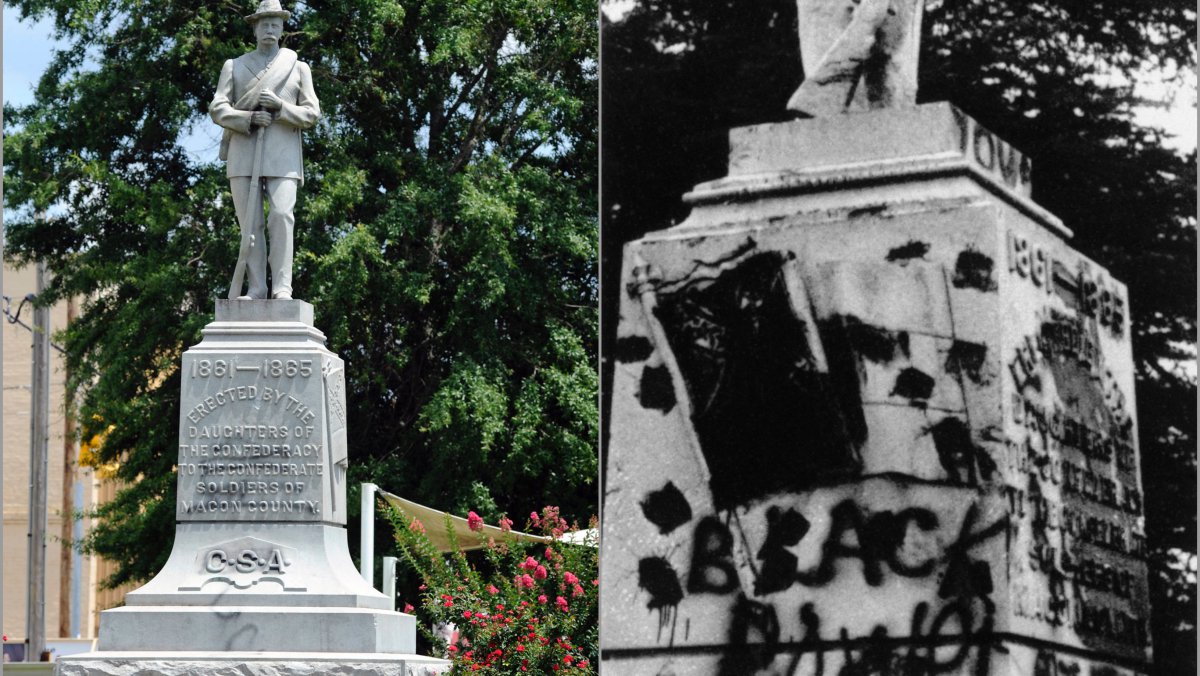[ad_1]
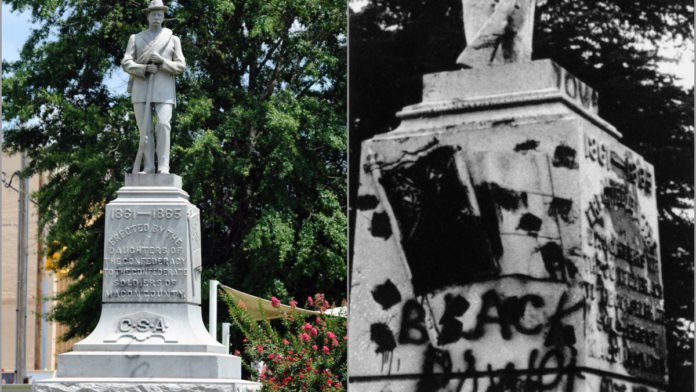
TUSKEGEE, Ala. (AP) — In 1906, when aging, white Confederate veterans of the Civil War and black ex-slaves still lived on the old plantations of the Deep South, two very different celebrations were afoot in this city known even then as a beacon of black empowerment.
Tuskegee Institute, founded to educate Southern blacks whose families had lived in bondage for generations, was saluting its 25th anniversary.
Meanwhile, area whites were preparing to dedicate a monument to rebel soldiers in a downtown park set aside exclusively for white people.
Flash forward to today and that same Confederate monument still stands in the same park, both of them owned by a Confederate heritage group. They sit in the heart of a poor, black-controlled town of 9,800 people that’s less than 3 percent white.
Students from what’s now Tuskegee University once tried and failed to tear down the old gray statue, which has since become a target for vandals. But critics who want it gone aren’t optimistic about removing it, even as similar monuments come down nationwide.
READ MORE: An off-duty police officer tasers 11-year old girl suspected of shoplifting
“I think it would probably take a bomb to get it down,” said Dyann Robinson, president of the Tuskegee Historic Preservation Commission.
The story of how such a monument could be erected and still remain in place a century later offers lessons in just how hard it can be to confront a shared history that still divides a nation.
READ MORE: Store clerk in Sante Fe called police on student because he is ‘arrogant and black’
In 1860, before the Civil War began, Census records show 1,020 white people owned 18,176 black people in Macon County, where Tuskegee sits. The enslaved were mostly kept uneducated. Schooling became nearly as big a need as food and shelter once the fighting stopped in 1865.
Established by the Alabama Legislature through the joint work of a freed slave and a former slave owner, the Tuskegee Normal and Industrial Institute was founded in 1881, according to the school’s official history. Booker T. Washington built it into a leading institution for educating blacks. To this day, it remains a leading historically black university.
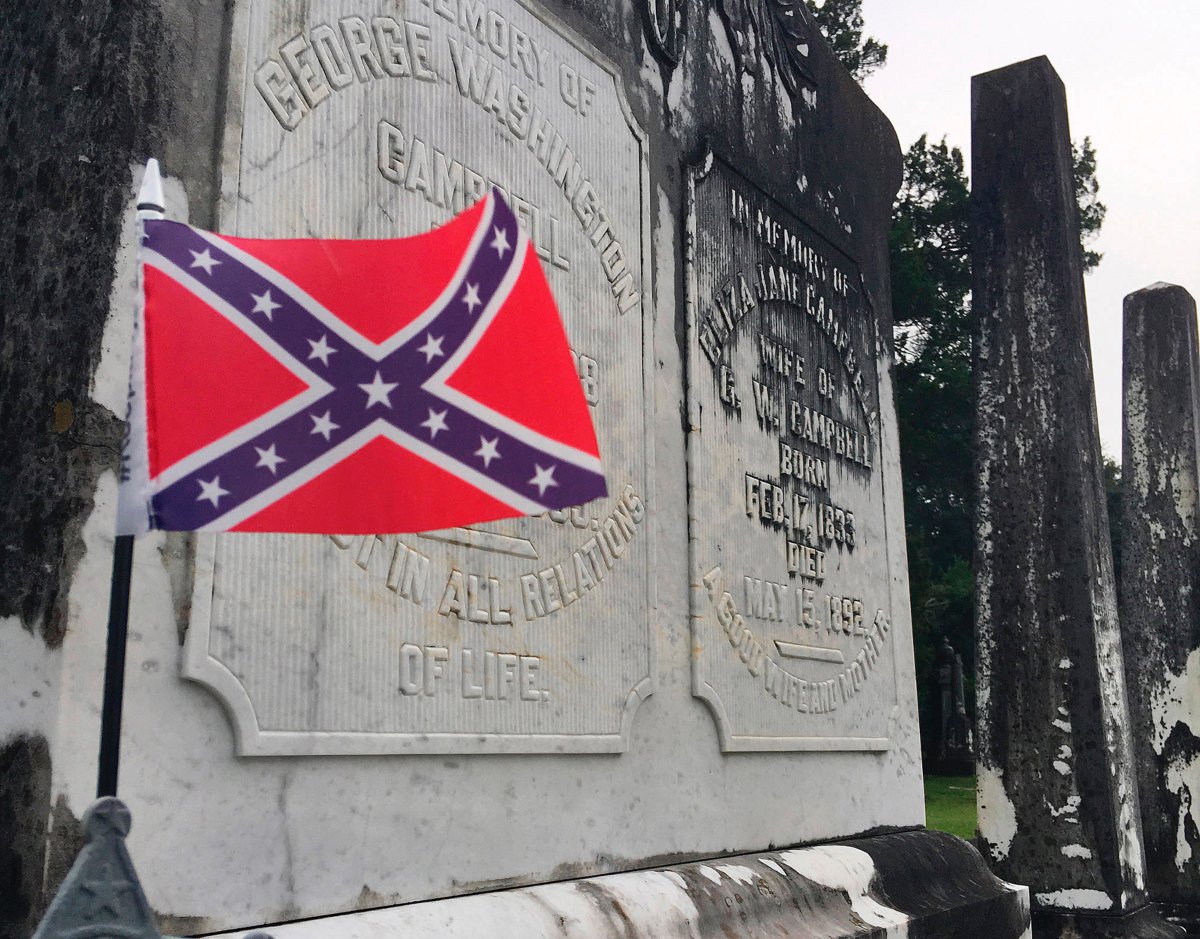
By the time of Tuskegee’s 25th anniversary, Washington was widely acclaimed for advocating practical education, character building and hard work to lift blacks from the poverty of the postwar South. William Howard Taft, who would become U.S. president a few years later, attended the celebration; so did industrialist and donor Andrew Carnegie.
Coverage of the anniversary festivities in The Tuskegee News, a white-owned newspaper, emphasized that blacks needed to get along with the whites who had near total control in the old Confederate states.
“Every address from northerner, or southerner, and black gave forth the unmistakable tribute to the value, yea, the absolute necessity of the southern negro doing all in his power to merit the confidence and friendly cooperation of the southern white man …,” the paper reported on its front page.
READ MORE: Trump supporter Candace Owens has epic meltdown on live tv debate with Michael Eric Dyson
Meanwhile, the United Daughters of the Confederacy, composed of female descendants of Confederate veterans, was erecting monuments glorifying the “lost cause” of the South all over the region in the early 1900s. The women of the Tuskegee chapter planned one for their town.
They staged a musical performance and a chrysanthemum show to raise money for a Confederate statue, according to Tuskegee News accounts. Then, two months after the Tuskegee Institute anniversary, leaders of the white-controlled county government gave the United Daughters the main downtown square to serve as a “park for white people” around a memorial to Macon County’s Confederate veterans, city records show.
The monument, which included the inscribed admonition to “honor the brave,” finally was dedicated on Oct. 6, 1909. The Montgomery Advertiser called the ceremony “one of the largest masses of white people ever before witnessed in Tuskegee.” Confederate flags waved and 13 young women were dressed in crimson and white to represent the Confederate states.
Newspaper stories from the time don’t say whether any blacks attended the event, which included a parade through town, but they most certainly were around. Macon County was around 82 percent black at the time, Census records show, although Jim Crow laws kept whites in firm political control.
The nation’s first black combat pilots, the Tuskegee Airmen, trained in the town in the 1940s, but not until the 1960s did the civil rights movement start changing political dynamics.
READ MORE: An off-duty police officer tasers 11-year old girl suspected of shoplifting
Blacks were first elected to office in Tuskegee in 1964, but whites still controlled most of Alabama. Frustrated after an all-white jury in another county acquitted a white man accused of murder in the shooting death of a civil rights worker, blacks took out their anger on the Confederate monument in 1966.
A crowd described in news reports as Tuskegee students converged downtown after jurors acquitted white gas station attendant Marvin Segrest in the killing of black Navy veteran and civil rights worker Samuel L. Younge Jr., who was gunned down after asking to use a whites-only bathroom. It took only 70 minutes or so for jurors to side with Segrest.
On a night when rocks flew through windows around the town square, demonstrators went after the Confederate monument.
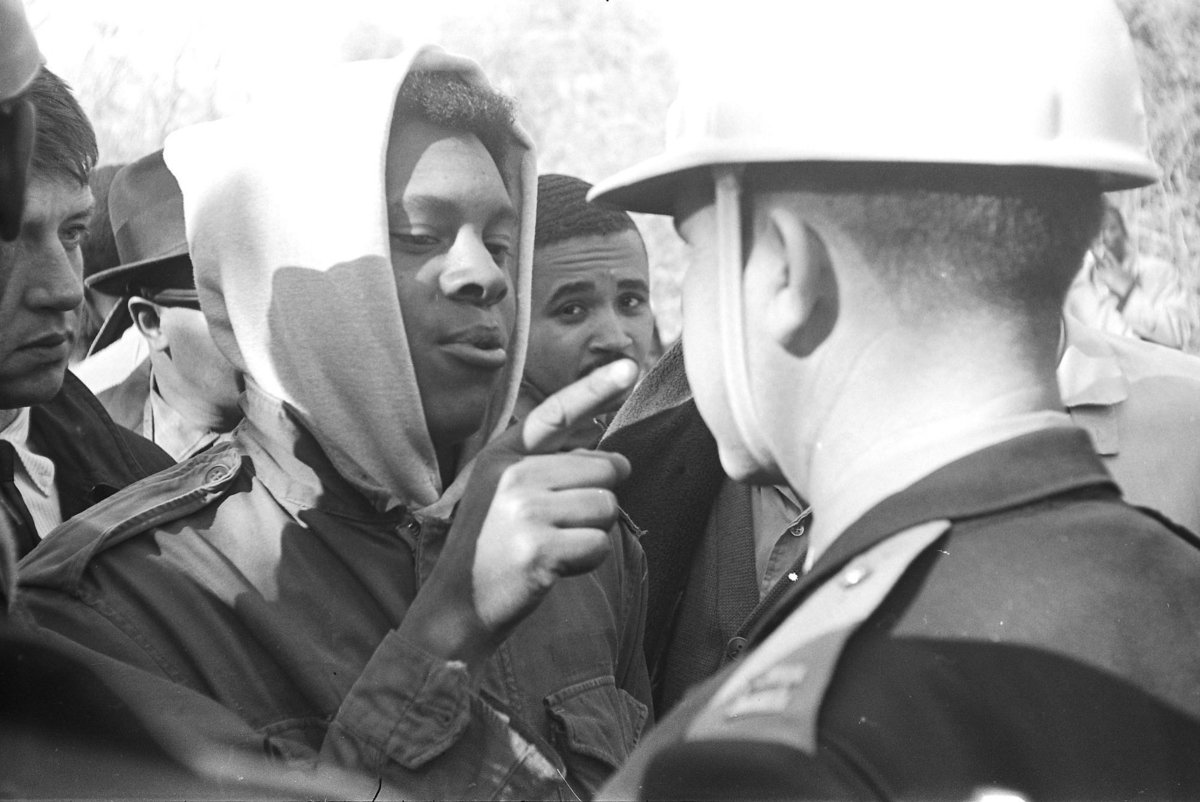
Simuel Schutz Jr., a friend of Younge who participated in the demonstration, said protesters attached a chain or rope to the monument in a bid to pull it down, but failed.
“We didn’t have a vehicle to topple it that night and that’s why it’s still there,” said Schutz, 72, now a contractor in Trenton, New Jersey.
But protesters did have spray paint. The next morning, the soldier atop the monument had a yellow stripe down its back with the words “black power” scrawled on the base in black paint.
First elected mayor in 1972, Johnny Ford said he tried to have the monument relocated after taking office and again in 2015. Both efforts failed, as did a few similar attempts during the intervening years.
“Whites oppose moving it and older blacks didn’t want to for fear of upsetting race relations,” said Ford, now out of office after serving more than three decades both as mayor and a state representative from the area.
For some, the statue is just part of the city’s landscape and isn’t much of an issue.
“It’s just part of Tuskegee, part of its history,” said Kelvin Stephens, a black man who works in a computer shop across a street from the memorial.
READ MORE: An off-duty police officer tasers 11-year old girl suspected of shoplifting
The United Daughters of the Confederacy still owns the square where the monument stands, and they don’t plan to remove it.
“It is a wonderful addition to the downtown area and has been there for over 100 years, and the United Daughters see no reason for it to change,” said a letter to the city by an attorney for the group, Richard L. Wyatt.
The 2-acre square has been open to everyone for years despite records that show it was supposed to be for only whites originally. Community members of all colors regularly gather on the green for events including the upcoming All Macon County Day, an annual event that will include hip-hop and rap music.
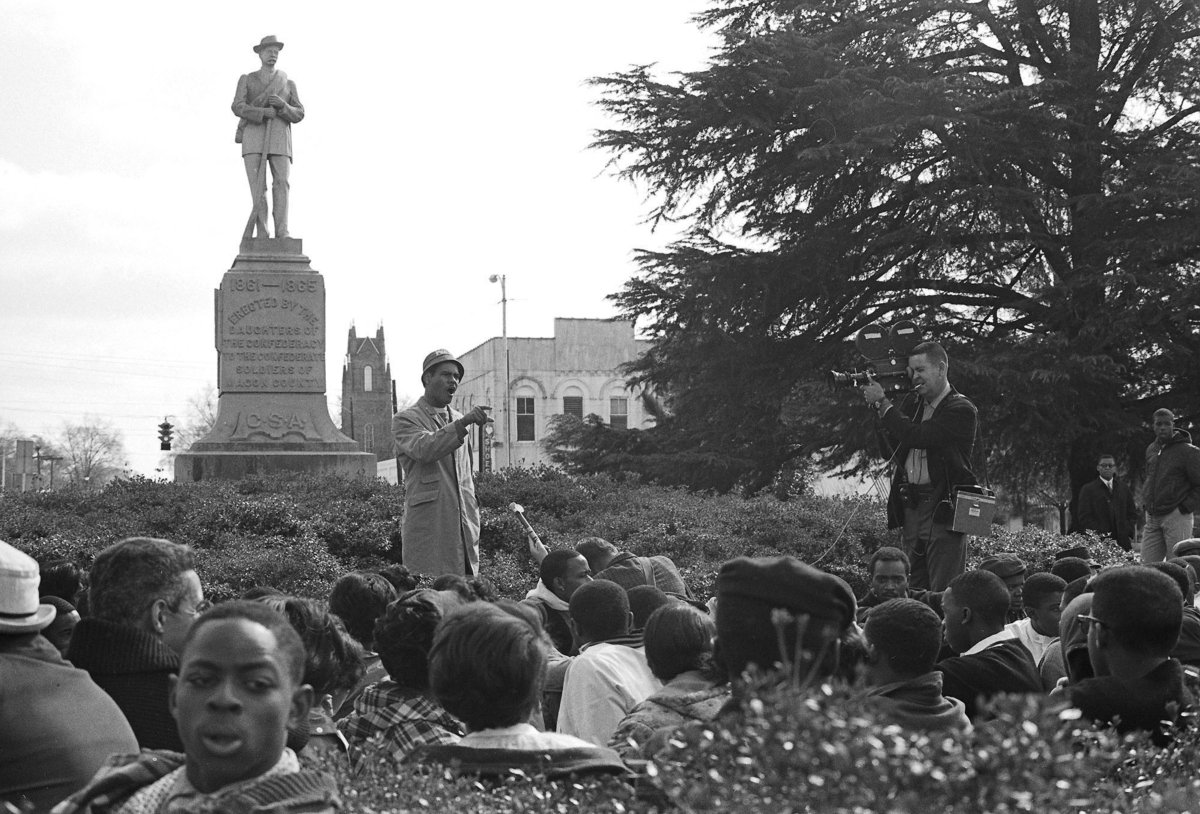
The city cuts the grass on the square and trims the rose bushes around the monument, but the United Daughters are in charge of the statue itself, officials said.
A United Daughters newsletter posted online shows the Tuskegee chapter faded away in 2001 only to be reactivated with eight members in 2014. A member of the United Daughters, speaking on condition of anonymity because of the sensitivity of the topic in town, said the chapter was revived in large part to protect and maintain the memorial.
The few members still in town cleaned the statue after vandals tagged it with spray paint about three years ago, Wyatt said in an interview, but they’ve yet to remove black paint that stains the gray stone following a similar incident in October. No one was charged in the vandalism.
The United Daughters member said the group decided against cleaning the statue after the latest incident out of fear it would only be repeated. “We started to but we decided to just let sleeping dogs lie,” she said.
Mayor Lawrence F. Haygood Jr. has said he understands why some people want the statue gone, but there are no moves afoot to remove it as the one-year anniversary approaches of a deadly confrontation over a Confederate monument in Charlottesville, Virginia.
It’s unclear whether anything can be done anyway, since Alabama legislators passed a law last year banning the removal or alteration of sites including Confederate monuments.
READ MORE: Store clerk in Sante Fe called police on student because he is ‘arrogant and black’
In Birmingham, city officials built a wooden box around a 52-foot-tall obelisk that was erected to honor Confederate veterans in 1905 in a downtown park, and the state sued to enforce the law. A judge’s upcoming ruling could clarify whether cities like Tuskegee can do anything about memorials that some find offensive and others revere.
In the meantime, Tuskegee’s stone Confederate stands in the middle of a nearly all-black city, the butt of his musket resting near the feet and the hands gripping the barrel.
“It’s just there in town like it’s always been,” said the mayor.
Associated Press news researcher Rhonda Shafner in New York contributed to this report.
[ad_2]
Source link

